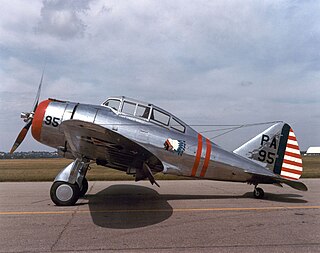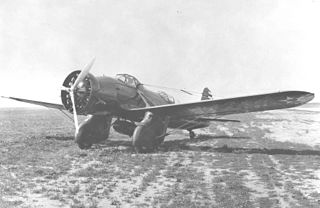
The Seversky P-35 is an American fighter aircraft built by the Seversky Aircraft Company in the late 1930s. A contemporary of the Hawker Hurricane and Messerschmitt Bf 109, the P-35 was the first single-seat fighter in United States Army Air Corps to feature all-metal construction, retractable landing gear, and an enclosed cockpit.

The Pratt & Whitney R-1340 Wasp is an aircraft engine of the reciprocating type that was widely used in American aircraft from the 1920s onward. It was the Pratt & Whitney aircraft company's first engine, and the first of the famed Wasp series. It was a single-row, nine-cylinder, air-cooled, radial design, and displaced 1,344 cubic inches (22 L); bore and stroke were both 5.75 in (146 mm). A total of 34,966 engines were produced.

The Pratt & Whitney R-1690 Hornet was a widely used American aircraft engine. Developed by Pratt & Whitney, 2,944 were produced from 1926 through 1942. It first flew in 1927. It was a single-row, 9-cylinder air-cooled radial design. Displacement was 1,690 cubic inches. It was built under license in Italy as the Fiat A.59. In Germany, the BMW 132 was a developed version of this engine. The R-1860 Hornet B was an enlarged version produced from 1929.

The Gee Bee Model R Super Sportster was a special-purpose racing aircraft made by Granville Brothers Aircraft of Springfield, Massachusetts at the now-abandoned Springfield Airport. Gee Bee stands for Granville Brothers.

The Curtiss SBC Helldiver was a two-seat scout bomber and dive bomber built by the Curtiss-Wright Corporation. It was the last military biplane procured by the United States Navy. Delivered in 1937, it became obsolete even before World War II and was kept well away from combat with Axis fighters.

The P-1 Hawk was a 1920s open-cockpit biplane fighter aircraft of the United States Army Air Corps. An earlier variant of the same aircraft had been designated PW-8 prior to 1925.

The Boeing YB-9 was the first all-metal monoplane bomber aircraft designed for the United States Army Air Corps. The YB-9 was an enlarged alteration of Boeing's Model 200 Monomail commercial transport.

The Curtiss YA-10 Shrike was a 1930s United States test and development version of the A-8 Shrike ground-attack aircraft using various radial engines in place of the inline Vee.

Granville Brothers Aircraft was an aircraft manufacturer from 1929 until its bankruptcy in 1934 that was located at the Springfield Airport in Springfield, Massachusetts. The Granville Brothers—Zantford, Thomas, Robert, Mark and Edward—are best known for the three Gee Bee Super Sportster racers, the Models Z, R-1 and R-2. Prior to building aircraft, Zantford ran a mobile aircraft repair service.

The Curtiss F6C Hawk was a late 1920s American naval biplane fighter aircraft. It was part of the long line of Curtiss Hawk airplanes built by the Curtiss Aeroplane and Motor Company for the American military.

The Curtiss F7C Seahawk was a carrier-capable biplane fighter aircraft of the United States Navy Marine Corps in the late 1920s and early 1930s.

The Bellanca 28-70 was a long-range air racer designed for James Fitzmaurice, Irish pioneer aviator, who christened it Irish Swoop. Although it was built in time for the 1934 MacRobertson Race from England to Australia, it was never destined to be a competitive long-distance racer but it was ultimately reborn as a high-speed bomber.

The Keystone LB-6 and LB-7 were 1920s American light bombers, built by the Keystone Aircraft company for the United States Army Air Corps, called Panther by the company, but adoption of the name was rejected by the U.S. Army.

The Gee Bee Model Y Senior Sportster was a sport aircraft built in the United States in the early 1930s by the Granville Brothers. Essentially an enlarged two-seat version of the single-seat Sportster, it was a low-wing strut-and-wire-braced monoplane of conventional design with open cockpits and fixed tailskid undercarriage. The first of the two examples constructed remained with the Granville Brothers company and competed in many races, piloted by Maude Tait and Russell Boardman, among others. Later it also served as a support aircraft for the R-1 and R-2 racers. The second Model Y was built to order for the Cord Auto Company to be used as an engine testbed for the Lycoming R-680 engine they produced. This aircraft was later refitted with a Wright Whirlwind of nearly double the power of its original powerplant. In this form, it was flown by Florence Klingensmith at the 1933 Chicago International Races, where she won second place in the Women's Free-For-All, then perished in the aircraft after fabric became detached from the upper right wing while contesting the Phillips Trophy.

The Curtiss XBTC was a prototype single-seat, single-engined torpedo/dive bomber developed during World War II for the United States Navy. Four aircraft were ordered, powered by two different engines, but the two aircraft to be fitted with the Wright R-3350 radial engine were cancelled in late 1942, leaving only the pair using the Pratt & Whitney R-4360 radial. By this time, Curtiss Aircraft was overwhelmed with work and the Navy gave the XBTC-2 prototypes a low priority which delayed progress so the first flight did not take place until the beginning of 1945. One aircraft crashed in early 1947 and the other was disposed of later that year.

The Granville Gee Bee Model Z was an American racing aircraft of the 1930s, the first of the Super Sportster aircraft built by Granville Brothers Aircraft of Springfield, Massachusetts, with the sole intent of winning the Thompson Trophy, which it did in 1931. However, it soon suffered a fatal crash during a world speed record attempt, starting the reputation of the Gee Bee aircraft as killers.

The Hawks Miller HM-1, named Time Flies was an American racing aircraft that was the joint project of pilot-owner, Frank Hawks and Howell W. "Pete" Miller, chief engineer for the Granville Brothers. Although very advanced for its time with an enclosed cockpit that highlighted its streamlined lines, development ended after a crash during testing. A completely new design emerged when the aircraft was re-configured as a two-seat military aircraft.

The Military Aircraft HM-1, derived from the earlier Hawks Miller HM-1 racing aircraft nicknamed, "Time Flies" was an American prototype attack/observation aircraft. The HM-1 did not achieve production after the sole example was destroyed during testing.
The C-8 Eightster was a single-engine airliner developed by Granville Brothers Aircraft that did not go into production.

The Gee Bee Model A was an American two-seat open cockpit single-bay biplane developed by the Granville Brothers that first flew in 1929.



























